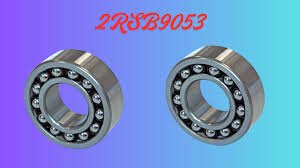What is 2rsb9053?
2rsb9053 is a remarkable identifier within its specific domain, representing a particular model or classification that has garnered significant attention in recent years. The nomenclature 2rsb9053 typically denotes a unique series or category that emerges from systematic research and development efforts across various industries. Through its evolution, it has established itself as a significant player due to its unique characteristics and applicability.
The origins of 2rsb9053 can be traced back to extensive studies aimed at improving existing standards and addressing specific industry needs. Researchers and developers acknowledged a gap in current methodologies and technologies, leading to the creation of 2rsb9053 as a reliable alternative. The recognition of this identifier is rooted in its ability to facilitate improved processes and outcomes in numerous applications.
One of the main features of 2rsb9053 is its adaptability across diverse sectors. This allows it to maintain relevance and efficacy, making it a sought-after solution. Its design reflects an intention to encompass a broad range of functionalities, which enhances its significance in practical scenarios. Moreover, its integration into existing frameworks has proven invaluable, signaling its importance in contemporary applications.
2rsb9053 stands out due to its unique combination of robustness and versatility. These qualities enable it to excel in an environment characterized by rapid technological advancement and changing consumer demands. As industries continue to evolve, the deployment and engagement with 2rsb9053 becomes increasingly vital, ensuring that it meets both current needs and anticipates future challenges.
Key Features of 2rsb9053
The 2rsb9053 is a versatile component designed for a variety of applications, particularly in the realm of electronics and mechanical engineering. It stands out due to its robustness and efficiency, which can address multiple needs across different sectors. One of its most notable features is its high durability, enabling the 2rsb9053 to function effectively even in demanding environments. Its design incorporates advanced materials that reduce wear and tear, making it a reliable choice for long-term use.
Additionally, the 2rsb9053 offers an impressive performance in terms of load bearing. It is engineered to support substantial weight while maintaining stability, which is crucial for applications that require precision and reliability. The product comes in several variants, allowing users to select the model that best fits their specific requirements. Such customization ensures that the 2rsb9053 can be integrated seamlessly into various systems, enhancing overall operational efficiency.
Another key feature is the ease of installation and maintenance associated with the 2rsb9053. Its intuitive design minimizes the time and effort needed for setup, making it accessible for users with varying levels of technical expertise. Moreover, routine maintenance can often be performed without specialized tools, further enhancing its appeal in busy work environments where downtime must be minimized.
The 2rsb9053 also boasts compatibility with numerous other components, which expands its functionality and user options. This interoperability makes it a preferred choice among engineers and designers who seek components that can work together harmoniously in complex setups. Overall, the combination of durability, performance, customizable features, and ease of use positions the 2rsb9053 as a leading choice in its category, appealing to a wide spectrum of industrial applications.

Applications of 2rsb9053
The 2rsb9053 is a versatile component employed across various industries, delivering solutions that enhance operational efficiencies. One prominent application of 2rsb9053 is in the electronics sector, where it serves as a crucial element in circuit design and development. Engineers have reported that integrating 2rsb9053 into their projects has led to improved circuit performance, resulting in faster processing times and reduced energy consumption. This enhancement not only boosts productivity but also contributes to sustainable practices in electronics manufacturing.
In the automotive industry, the 2rsb9053 has found its place in modern vehicle systems, particularly in advanced driver-assistance systems (ADAS). The precision and reliability of 2rsb9053 make it an ideal component for various sensors used in lane-keeping assistance, adaptive cruise control, and collision avoidance systems. Automotive specialists have noted that the implementation of 2rsb9053 has significantly increased the safety and functionality of modern vehicles, addressing critical consumer demands for security and efficiency on the road.
Moreover, the healthcare sector has embraced the applications of 2rsb9053, utilizing it in medical devices and diagnostic equipment. The accuracy and reliability of 2rsb9053 ensure that critical measurements are both precise and trustworthy, which is paramount in patient care and treatment. Medical professionals have provided positive feedback regarding the impact of 2rsb9053 on patient outcomes, particularly in diagnostic imaging and monitoring systems that rely on precise readings for timely interventions.
Overall, 2rsb9053 stands out as a multifaceted solution across a spectrum of applications, solving specific industry challenges while enhancing efficiency and effectiveness. Its relevance in contemporary technological advancements cannot be overstated, as it continues to shape the landscape across various fields.
Future Prospects of 2rsb9053
As we look ahead, the future prospects of 2rsb9053 are marked by both exciting opportunities and potential challenges. This multifaceted compound is anticipated to expand its influence across various sectors, particularly in technology and material sciences. Experts predict that advancements in synthesis techniques and applications will enhance the performance and efficiency of 2rsb9053, making it a prime candidate for innovative developments.
One notable trend is the increasing focus on sustainability and eco-friendliness in materials and technologies. With a growing demand for sustainable solutions, 2rsb9053 is well-positioned to adapt to this shift. Research is ongoing into its potential applications within renewable energy sectors, including solar cells and energy storage systems, where its performance could provide significant advantages over existing materials.
Furthermore, the advent of new technologies such as artificial intelligence and machine learning may play a pivotal role in the future evolution of 2rsb9053. The integration of these technologies could lead to the development of smarter, more efficient applications, enhancing its adaptability and functionality across different industries. Industry experts are optimistic about the synergy between 2rsb9053 and emerging technological innovations, which may catalyze further exploration of its capabilities.
However, challenges remain. The continuous evolution of competing materials and the need for rigorous testing to ensure efficacy and safety are pertinent issues that the industry must address. These factors could create barriers to the widespread adoption of 2rsb9053, necessitating ongoing research and development efforts to mitigate such challenges.
In conclusion, the future of 2rsb9053 appears promising, with a substantial potential for growth and adaptation. The compound is poised to remain relevant in an ever-changing technological landscape, provided that researchers and industry stakeholders continue to innovate and overcome the obstacles that lie ahead.



